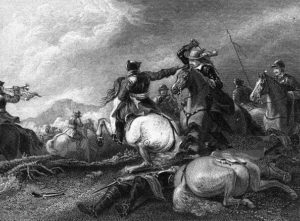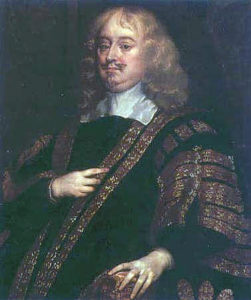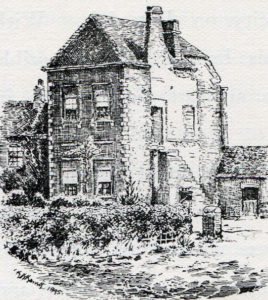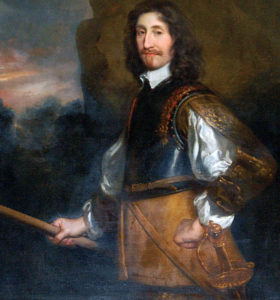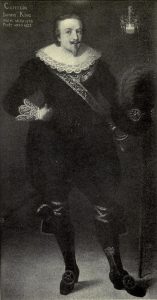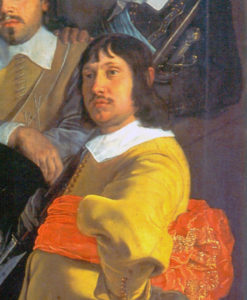The battle that destroyed the Royalist cause in the North of England, fought on 2nd July 1644
The previous battle in the English Civil War is the Battle of Cropredy Bridge
The next battle in the English Civil War is the Battle of Lostwithiel
To the English Civil War index
Battle: Marston Moor
War: English Civil War
Date of the Battle of Marston Moor: 2nd July 1644
Place of the Battle of Marston Moor: Between Long Marston and Tockwith, six miles to the west of the city of York.
Combatants at the Battle of Marston Moor:
The Royalist forces of King Charles I against the forces of Parliament and the Scottish Covenanters.
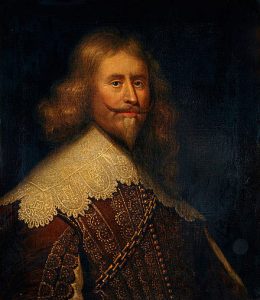
Alexander Leslie, the Earl of Leven, commanding the Scottish Covenanter army at the Battle of Marston Moor on 2nd July 1644 in the English Civil War
Commanders at the Battle of Marston Moor: Prince Rupert nephew to King Charles I commanded the Royalist army with the Earl of Newcastle and Lord Eythin as his deputies.
Alexander Leslie, the Earl of Leven, commanded the Scottish Covenanter contingent in the Parliamentary-Scots army.
Lord Fairfax and the Earl of Manchester commanded the two Parliamentary forces in the Parliamentary-Scots army.
Size of the armies at the Battle of Marston Moor:
Prince Rupert marched to the relief of York with 5,000 Horse and Dragoons and 9,000 Foot.
The Earl of Newcastle and Lord Eythin brought from the York garrison a further 4,000 Foot.
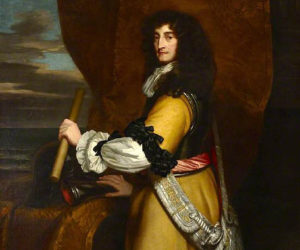
Prince Rupert, commander of the Royalist army at the Battle of Marston Moor on 2nd July 1644 in the English Civil War
The Royalists brought some 20 guns into the field.
The Scots Covenanter army comprised 16,000 troops.
Lord Fairfax commanded 5,000 troops.
The Early of Manchester brought a further 6,000 troops to the battle.
The Parliamentary-Scots army at the Battle of Marston comprised some 7,000 Horse and Dragoons, 20,000 Foot and some 30 guns.
Winner of the Battle of Marston Moor: Marston Moor was a heavy defeat for the Royalist cause of King Charles I.
Uniforms, arms and equipment at the Battle of Marston Moor:
See this section in the Battle of Edgehill.
Background to the Battle of Marston Moor:
In early July 1644 the City of York, held for King Charles I by a Royalist army commanded by the Earl of Newcastle, was under siege by Lord Fairfax with his Parliamentary army and Alexander Leslie, Lord Leven, with his army of Scots Covenanters.
On 14th July 1644 King Charles I wrote to his nephew Prince Rupert, who was preparing to march to the relief of the City of York: ‘…But if York be relieved, and you beat the rebels’ army of Both Kingdoms, which are before it; then (but not otherwise) I may possibly make a shift (upon the defensive) to spin out time until you come to assist me. Wherefore I command and conjure you, by the duty and affection which I know you bear me, that all new enterprises laid aside, you immediately march, according to your first intention, with all your force to the relief of York.’
When King Charles I’s adviser Lord Culpeper heard of the content of the letter sent to Prince Rupert he exclaimed to the King: ‘Why, then, before God you are undone, for upon this peremptory order he will fight, whatever comes on’t.’ Culpeper’s comment was ominously percipient. Prince Rupert needed little encouragement. His fundamental principal in warfare was aggression to the point of extreme rashness.
The Earl of Newcastle with his deputy the Scottish Catholic James King, recently elevated as Lord Eythin, commanded the Royalist garrison of 4,500 Foot and 300 Horse.
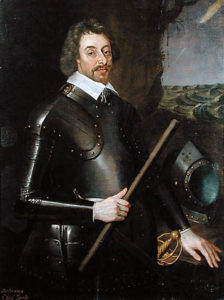
Ferdinando, 2nd Lord Fairfax, Parliamentary Commander at the Battle of Marston Moor on 2nd July 1644 in the English Civil War
The siege of the city began on 22nd April 1644. Straightaway the Royalist commanders impounded staple foods and imposed rationing on the population.
The forces of the besiegers comprised 16,000 Scots troops and 5,000 Parliamentary troops. On 3rd June 1644 this force was increased by the arrival of the Earl of Manchester’s force of some 7,000 men, bringing the total besieging army to 28,000.
On 16th June 1644 major assaults were launched against the city defences but were repelled with significant Parliamentary casualties.
In late June 1644 Prince Rupert marched to the relief of York crossing the Pennines and arriving at Skipton Castle on 26th June 1644. After a pause to receive reinforcements from the north and to put his army in order Prince Rupert marched on, reaching Knaresborough on 30th June 1644, thirteen miles to the west of York.
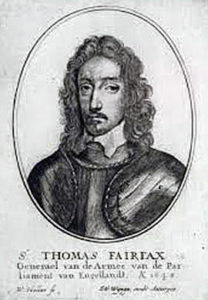
Sir Thomas Fairfax, known as ‘Black Tom’, commander of the Parliamentary right wing at the Battle of Marston Moor on 2nd July 1644 in the English Civil War
The Parliamentary-Scots army was forced to abandon the siege by the sudden arrival of Prince Rupert’s relieving army and moved to intercept Prince Rupert, taking up a position near the village of Long Marston, some six miles to the west of York.
On 1st July 1644, on the approach of a large body of Royalist Horse, Fairfax and Leslie formed their army for battle at Long Marston. But the threat from the Royalist Horse was a feint. Prince Rupert’s main army marched north-east from Knaresborough in a semi-circle around the Parliamentary-Scots army, crossed the River Ure at Boroughbridge and continued north-east, crossing the River Swale at Thornton Bridge before turning south-east to march down the Ouse Valley to York.
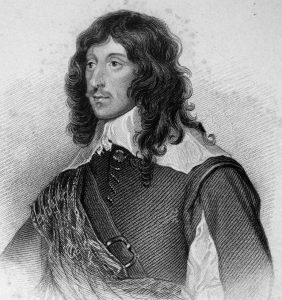
Lord George Goring, commander of the Horse on the Royalist left wing: Battle of Marston Moor on 2nd July 1644 in the English Civil War
At Poppleton outside the city Prince Rupert captured a pontoon bridge from a party of Parliamentary dragoons before sending Lord George Goring into York with a body of Horse, while remaining outside the city with the rest of his army. Prince Rupert had completed the mission urged on him by the King of relieving the city. But Prince Rupert was not satisfied with this substantial achievement. He intended to bring the combined army of Fairfax and Leslie to battle.
The Earl of Newcastle and Lord Eythin were reluctant to fight the Parliamentary-Scots army on such unequal terms, particularly as York had been relieved and further Royalist reinforcements were expected of some 2,000 men commanded by Colonel Sir Robert Clavering.
In the light of the King’s letter to Prince Rupert commanding him to defeat the Parliamentary-Scots army the Earl of Newcastle and Lord Eythin reluctantly agreed with Prince Rupert’s plan to bring the Parliamentary-Scots army to battle. This would add Newcastle’s disciplined and motivated ‘White Coats’ to Prince Rupert’s army.
Account of the Battle of Marston Moor:
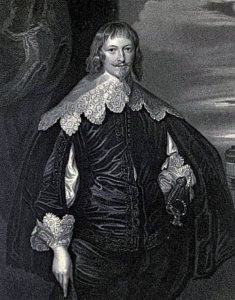
Earl of Newcastle, Royalist commander at the Battle of Marston Moor 2nd July 1644 in the English Civil War
On 2nd July 1644 Prince Rupert’s army broke camp outside York and marched out for Little Marston.
By this time the Parliamentary-Scots army was on the move towards Tadcaster to meet an approaching force commanded by Sir John Meldrum, before making further efforts to bring the Royalists to battle.
As the Royalist army marched onto Marston Moor the Parliamentary-Scots army halted and returned to the moor.
During the course of the day Marston Moor filled up with the troops of both sides taking up positions for the forthcoming battle.
The Earl of Newcastle’s and Lord Eythin’s troops marching from York after some delay did not arrive and form up for battle until well into the afternoon. It took the same length of time for the Parliamentary-Scots army to be recalled from their march and brought onto Marston Moor.
The delay in bringing the troops from the Royalist York garrison prevented Prince Rupert from launching his attack on the Parliamentary-Scots army as it marched onto the moor and before it could be put into dispositions for battle.

Oliver Cromwell leading his ‘Ironsides’ back from the Battle of Marston Moor on 2nd July 1644 in the English Civil War
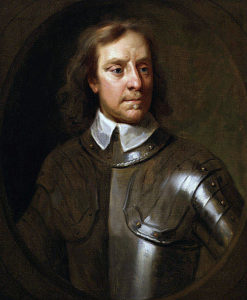
Olive Cromwell, whose charge was decisive at the Battle of Marston Moor on 2nd July 1644 in the English Civil War
The Parliamentary-Scots troops as they arrived on the moor from the south-west formed up along the top of the rising ground running west to east parallel to the Long Marston to Tockwith Road. The Royalist army took position on the northern side of the road facing up the rising ground.
Much of the moorland was broken and covered in furze. In front of the Royalist position ran a long ditch backed by a hedge.
On the Royalist left wing Prince Rupert positioned a body of 2,100 Horse commanded by Lord George Goring and his deputy Sir Charles Lucas. The brigades of Horse were interspersed with musketeers in platoons of 50 in the Swedish style.
The Royalist Foot was drawn up in the centre of the army in three lines with Sir William Blakiston’s Brigade of Horse in the third line. The Earl of Newcastle’s and Lord Eythin’s troops were incorporated into this force as they arrived on the battlefield. The Royalist Foot was commanded by their respective Sergeant-Major-Generals, Henry Tillier leading Prince Rupert’s and Sir Francis Mackworth Lord Newcastle’s.
On the Royalist right wing Prince Rupert positioned a force of 2,000 Horse commanded by Lord Byron with Sir John Urry as his deputy, again the brigades interspersed with platoons of musketeers.
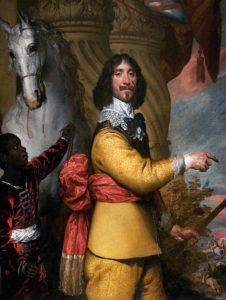
Lord Byron, commander of the Royalist right wing at the Battle of Marston Moor on 2nd July 1644 in the English Civil War
Prince Rupert’s Life Guard and Sir Edward Widdrington’s brigade of Horse formed the reserve under Prince Rupert’s immediate direction.
In the left rear of the Royalist position stood an enclosure called White Syke Close that featured prominently as a defensive position towards the end of the battle.
A body of Foot was posted along the ditch on the right wing in front of Lord Byron’s Horse supported by four drakes or light cannon.
The Parliamentary-Scots army, comprising the armies of Lord Leven’s Scots Covenanters, Lord Fairfax’s English Parliamentary army and Lord Manchester’s English Parliamentary army formed up in three sections, each of three ranks, the brigades from each force intermingled.
On the left stood a body of Horse, the Parliamentary regiments commanded by Oliver Cromwell and the Scots regiments by Major-General David Leslie. The first line comprised Parliamentary Horse and Fraser’s Dragoons, the second line Parliamentary Horse and the third line Scots Horse under Leslie.
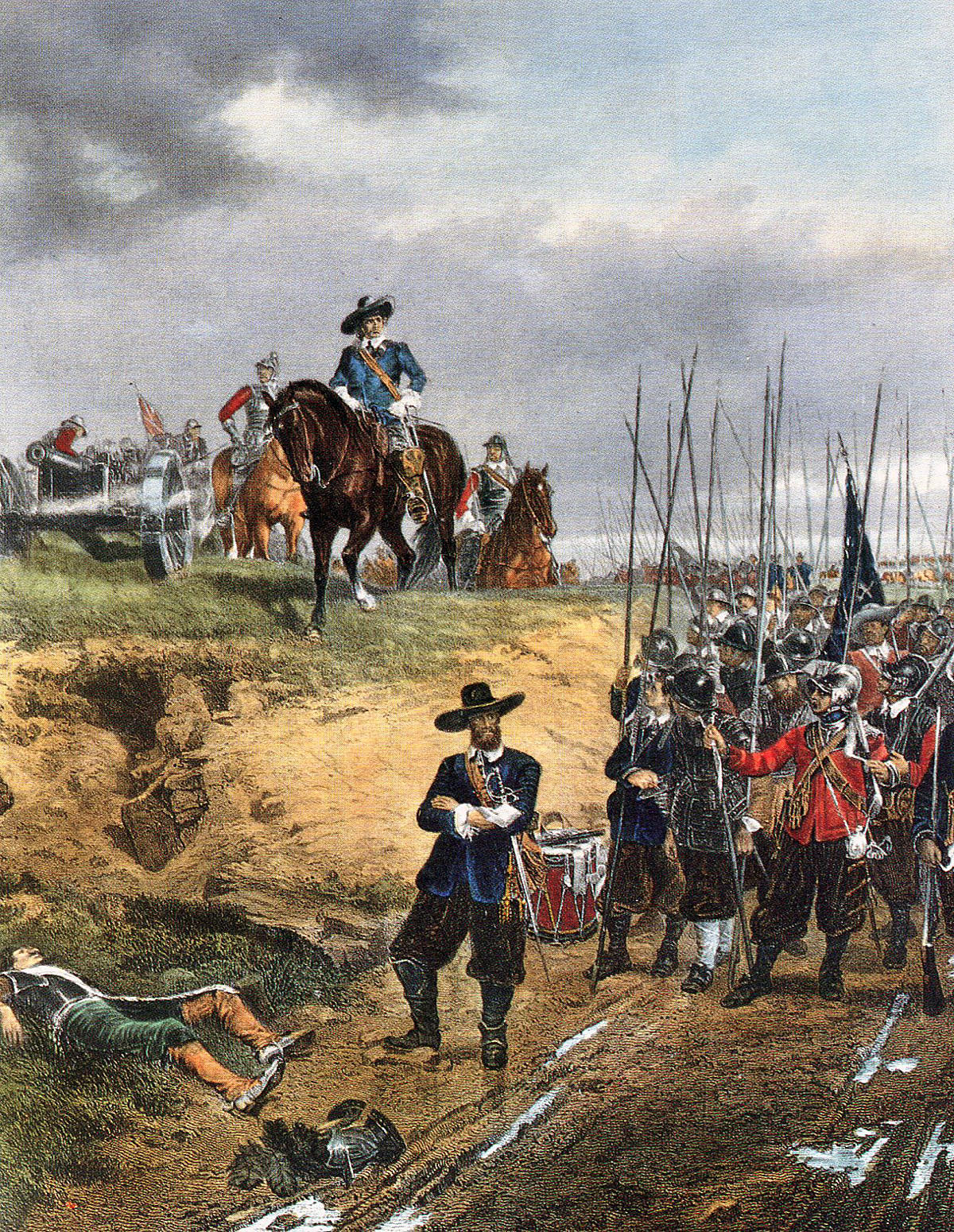
Oliver Cromwell and a regiment of Parliamentary Foot at the Battle of Marston Moor on 2nd July 1644 in the English Civil War: picture by Ernest Crofts
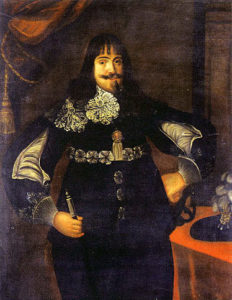
Major-General Sir James Lumsden, commanding the second rank of Foot in the centre of the Parliamentary-Scots army at the Battle of Marston Moor on 2nd July 1644 in the English Civil War
The main body of Parliamentary-Scots Foot formed up in the centre. As with the Horse the Parliamentary and Scots brigades were intermingled, five brigades forming the first rank with three brigades in each of the other two ranks and one brigade in reserve. Lieutenant-General Baillie and Major-General Crawford commanded the first line, which included two of the Earl of Manchester’s brigades. Major-General Sir James Lumsden commanded the second line and Lord Manchester the third.
On the Parliamentary-Scots right was positioned a body of Horse commanded by Sir Thomas Fairfax, the first and second lines being Parliamentary and the third line Scots commanded by the Earl of Eglinton.
The Parliamentary-Scots army was formed up by Major-General Sir James Lumsden who rode down the line giving directions and making a sketch of the Parliamentary-Scots dispositions.
In the right rear of the Parliamentary-Scots position stood a group of trees on a slight promontory used by the commanders as a point of vantage that came to be known as ‘Cromwell’s Plump’.
Lord Leven, in overall command of the Parliamentary-Scots army, intended to attack the smaller Royalist army of Prince Rupert as soon as his troops were in position.
On the Royalist left Prince Rupert’s cavalry moved forward and skirmishing took place until the Royalist Horse came under cannon fire from the Parliamentary-Scots line and withdrew.

Marston Moor, looking east to York: Battle of Marston Moor on 2nd July 1644 in the English Civil War: drawing by C.R.B. Barrett
Prince Rupert told the Earl of Newcastle that in view of the lateness of the hour he would spend the night on the moor and attack the Parliamentary-Scots army in the morning. Prince Rupert dismounted to take supper while Newcastle withdrew to his carriage for a ‘quiet pipe of tobacco’.

Parliamentary-Scots Cavalry of Cromwell’s left wing engage Lord Byron’s Royalist Horse in the opening charge of the Battle of Marston Moor on 2nd July 1644 in the English Civil War: picture by John DE Walton
At around 7pm on a signal gun the Parliamentary-Scots army advanced down the incline to attack the Royalist line.
At about the same time a squall of rain struck the moor, the first of several during the ensuing battle, extinguishing the smouldering fuses of many of the Royalist musketeers positioned along the hedgerow behind the ditch.

Marston Moor, looking north from the Parliamentary Scots position towards the Royalist position at the Battle of Marston Moor on 2nd July 1644 in the English Civil War: drawing by C.R.B. Barrett
As the Parliamentary-Scots reached the ditch they were met with a volley from those Royalist musketeers whose fuses were alight and the four light cannon or ‘drakes’ but they quickly crossed the ditch and sweeping the Royalist musketeers aside to engage the main body of Royalists.
The Parliamentary-Scots Horse on the right with difficulty crossed the ditch and the scrubby moorland before being subjected to a galling fire from the Royalist ‘commanded musketeers’ interspersed among Lord Goring’s Horse.
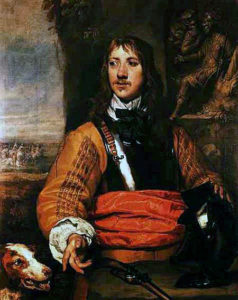
Sir Charles Lucas, deputy commander of the Royalist left wing at the Battle of Marston Moor 2nd July 1644 in the English Civil War
Sir Thomas Fairfax with a strong body of Horse drove the Royalist regiments on the extreme flank off the field and, in the spirit and tradition of English Civil War battles, pursued them much of the way to York.
Lord Goring launched a vigorous charge on the rest of Fairfax’s wing so that on his return Fairfax found his deputy Lambert in trouble, many of his Parliamentary troopers fleeing the battlefield. Fairfax’s brother Colonel Charles Fairfax lay mortally wounded after being abandoned by his men.
The three Scots regiments of the third line on the right wing were roughly handled by the Royalist Horse and forced to retreat pursued by Goring’s troopers.
Sir Charles Lucas kept a body of Horse sufficiently well in hand to enable him to turn and attack the flank of the Parliamentary-Scots Foot as they advanced on the Royalist centre.
On the left Cromwell’s first line of Horse passed the ditch after Fraser’s Scots Dragoons mopped up the musketeers positioned behind the hedge. The Royalist right wing commander Lord Byron advanced to the attack with his Horse. Cromwell’s Eastern Association Horse met Byron’s men and drove them off the battlefield, although Cromwell was wounded in the arm.
Prince Rupert had been dismounted when the Parliamentary-Scots launched their attack. The Prince mounted at once and surveyed the battlefield. The Royalist left wing was winning and the Royalist Foot in the centre was holding the Parliamentary-Scots attack. It was on the right flank that the Royalist army was in trouble with Byron’s heavy defeat by Cromwell’s Eastern Association Horse.

Cavalry Action at the time of the English Civil War: Battle of Marston Moor 2nd July 1644 in the English Civil War
Prince Rupert rode to the threatened Royalist right wing with his Life Guard and Sir Edward Widdrington’s brigade of Horse from the Royalist reserve.
Cromwell is thought to have withdrawn to have his wound dressed at this point and his Horse was commanded by Major-General Lawrence Crawford. Attacked in front and in flank by Prince Rupert’s horsemen Cromwell’s Eastern Association Horse were hard pressed to hold their own until Major-General David Leslie charged with his three Scots regiments from the third rank.
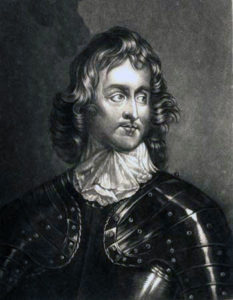
Major-General Sir John Lambert, a Parliamentary cavalry commander on the right wing at the Battle of Marston Moor on 2nd July 1644 in the English Civil War
After a fierce resistance by Prince Rupert’s Life Guard and Sir Edward Widdrington’s brigade, the Royalist Horse on the right wing was finally driven back in disorder, many of the troopers making off towards York. Prince Rupert was separated from his men and forced to hide in a bean field while Sir John Urry attempted to rally the retreating Royalists on the York road.
In the centre the Earl of Newcastle’s White Coats were holding the Parliamentary-Scots attack. Sir William Blakiston’s brigade of Horse charged through the Parliamentary-Scots Foot to the top of the rise, dispersing the foot soldiers as they rode through them. The Earl of Newcastle accompanied the charge with his personal escort of Sir Thomas Metham’s troop, Newcastle himself killing three men with a sword borrowed from his page.
Sir Charles Lucas attacked the flank of the Parliamentary-Scots centre with his Horse from the Royalist left wing, but here the Scots brigade of Foot commanded by Lord Lindsey comprising the Fifeshire and Midlothian regiments held firm, holding back the Royalist Horse in spite of three ferocious charges, until Sir Charles Lucas’s horse was killed and he was captured.
Elsewhere in the centre the Parliamentary-Scots line of Foot came close to collapse.

Oliver Cromwell leads his ‘Ironsides’ to the attack on the Royalist Centre: the Battle of Marston Moor on 2nd July 1644 in the English Civil War
Sir Thomas Fairfax removed his white emblem showing that he was a Parliamentary officer and rode through the fighting to reach Cromwell on the left flank.
Fairfax ordered Cromwell to attack. Cromwell’s Eastern Association Horse were opposed by the remnants of Lord Goring’s Horse but swept them aside and descended on the Royalist centre, leaving the Royalist Horse to disperse and make their way back to York.

Attack of Cromwell’s Parliamentary Eastern Association Horse on the Royalist Foot at the Battle of Marston Moor on 2nd July 1644 in the English Civil War: picture by Henri Louis Dupray
The Royalist Foot were forced back until they held a position between White Syke Close and Moor Lane, Newcastle’s White Coats occupying the White Syke Close.

Marston Moor, looking south from the Royalist position towards the Parliamentary Scots position at the Battle of Marston Moor on 2nd July 1644 in the English Civil War: drawing by C.R.B. Barrett
The White Coats resisted Cromwell’s Eastern Association Horse fiercely with muskets and pikes, keeping them out of the White Syke Close for an hour. Finally, the White Coats were overrun and died in their ranks almost to a man, refusing to ask for quarter. It is said that only thirty White Coats survived the battle.
The rest of the remaining Royalist Foot were dispersed, killed or captured. The battle was over by 9pm.

Last stand of the Royalist Foot at the Battle of Marston Moor on 2nd July 1644 in the English Civil War
Casualties at the Battle of Marston Moor:
The Parliamentary authorities claimed to have lost only 300 men. This figure does not appear to have included Scots casualties. Seymour discounts the figure and estimates the Parliamentary-Scots casualties at around 1,500.
Parliamentary-Scots officers killed in the battle included: Major Fairfax, Charles Fairfax (brother of Sir Thomas Fairfax), Captains Micklethwaite and Pugh.
Oliver Cromwell’s nephew Captain Walton was wounded.
Parliamentary-Scots sources put Royalist casualties at 3,000 to 4,000 killed and 1,500 captured. Many more deserted and left for their homes.
Royalist officers killed in the battle included: Lord Kerry, Sir William Wentworth, Sir Francis Dacres, Sir William Lampton, Sir Charles Slingsby, Colonel John Fenwick, Sir Marmaduke Luddon, Sir Thomas Wetham, Sir Richard Gledhill and Captain John Baird. Of these Sir Richard Gledhill suffered twenty-six wounds in the battle but managed to ride to his home in Norton Conyers in North Yorkshire the same night dying an hour after he arrived.

Death of Sir William Lambton at the Battle of Marston Moor on 2nd July 1644 in the English Civil War: picture by Richard Ansdell
Follow-up to the Battle of Marston Moor:
The roads to York after the battle were described as being lined with dead and dying Royalist troops. Sir Thomas Glenham commanding the York garrison initially closed the city gates to ensure that no Parliamentary-Scots entered on the heels of the Royalist troops. Prince Rupert arrived at the end of the column and the gates were opened.
The day after the battle and after a hostile exchange with Lord Newcastle, Prince Rupert rode off towards Richmond in North Yorkshire with the remains of his cavalry. Lord Newcastle and Lord Eythin took ship from Scarborough to Hamburg and went into exile.
The City of York surrendered to the Parliamentary-Scots army on 12th July 1644, the garrison marching out with full honours of war. Thereafter the Royalist strongholds in the North of England were captured in turn, the last being Newark which surrendered on the King’s order on 2nd July 1645.
Clarendon on the Battle of Marston Moor: In his contemporary and authoritative work on the English Civil War entitled ‘History of the Great Rebellion’ the Earl of Clarendon, a Royalist and adviser to King Charles I could not conceal his exasperation when writing of the Battle of Marston, considering the opportunity to overcome the ‘Rebels’ to have been thrown away by Prince Rupert and to a lesser extent by Lord Newcastle. The points Clarendon makes are:
- After his brilliant march to relieve the City of York, which forced the Parliamentary-Scots army to raise the siege of the city there was no need for Prince Rupert to seek battle with the substantially larger Parliamentary-Scots army of Lord Leven and Lord Fairfax. As Lord Newcastle and Lord Eythin forcefully pressed on Prince Rupert relations between the Scots and the Parliamentary English were deteriorating so fast that the Parliamentary-Scots army was likely to fall apart, particularly after the debacle of Prince Rupert’s relief of the City.
- The forcing of the Parliamentary-Scots army to give battle temporarily patched over the quarrels between the two components of the combined army.
- The Royalist army was winning the battle until Fairfax and Cromwell charged with the English Horse of the left wing. Clarendon considers the discipline and determination of Cromwell’s Eastern Association Horse decisive in defeating Prince Rupert’s army.
- Even then the Parliamentary-Scots army suffered so badly in the battle and was so scattered that Prince Rupert and Lord Newcastle could have retrieved the situation and held York. It took two days to gather the Parliamentary-Scots troops and Royalist reinforcements were on the march to York at the time of the battle. Within a short time the Scots Covenanter army of Lord Leven would have returned to Scotland to deal with the rising by the Marquis of Montrose, leaving a weakened Parliamentary army.
- Instead of holding York, Prince Rupert rode off with his cavalry the morning after the battle to Richmond and Lord Newcastle left England for the Continent leaving the whole of the North of England to be reduced by the Parliamentary forces.
- Clarendon states that the King’s letter to Prince Rupert was not a direction to fight the Parliamentary-Scots under any circumstances.
Anecdotes and traditions from the Battle of Marston Moor:
- Tradition in the area of Long Marston has it that a local boy was ploughing on Marston Moor when, much to his astonishment, the area filled up with the troops from the opposing armies, Tradition does not say what he then did. Presumably he took his horses home as quickly as possible before they could be conscripted into the service of one of the armies. Of course he may have stolidly carried on ploughing.
- The Royalist officer Sir Bernard de Gomme made a plan of the armies’ formations before the battle began. The plan is in the British Museum. Sir Bernard became chief engineer to King Charles II after the Restoration and designed Tilbury Fort. The plan of the Battle of Marston Moor gives no indication of the number of guns on either side or where they were positioned.
- Many of the senior officers at the Battle of Marston Moor had experience of service in European Armies during the Thirty Years War. Alexander Leslie Lord Leven had risen to the rank of Field Marshal in the Swedish army of King Gustav Adolph.
- The Scots senior officers Major-General David Leslie and Major-General Sir James Lumsden were also veterans of King Gustav Adolph’s Swedish army.
- Relations between Prince Rupert and Lords Newcastle and Eythin were far from easy. Newcastle and Eythin were reluctant to risk battle with the superior Parliamentary-Scots army and appear only to have agreed when confronted with the King’s letter to Prince Rupert which he referred to but did not show them.
- James King, Lord Eythin, a Scots Catholic was a Royalist veteran of the Swedish service of King Gustav Adolph. Lord Eythin, Lord Leven and Prince Rupert served together at the Battle of Vlotho in 1638 when the Scottish-English force in the Swedish service was defeated by the Imperialists and Prince Rupert was forced to surrender. Lord Eythin blamed Prince Rupert’s impetuousness for the defeat while Prince Rupert blamed Eythin for his caution. It is ironic that the two commanders should meet again at Marston Moor, a battle fought and lost arguably due to Prince Rupert’s impetuousness in giving battle to a much stronger opponent commanded by their old comrade from the 30 Years War Patrick Ruthven, Lord Leven. On seeing Prince Rupert’s deployment on Marston Moor, Lord Eythin commented to Prince Rupert ‘By God, Sir, it is very fine in the paper, but there is no such thing in the field. Sir, your forwardness lost us the day in Germany, where you yourself was taken prisoner.’
- Lord George Goring served in the Dutch army before taking a commission in King Charles I’s service.
- Sir Charles Lucas, Lord Goring’s Lieutenant General on the Royalist left wing was made prisoner in the battle but later exchanged. Captured for a second time Lucas was paroled on condition he did not again take up arms against Parliament. In 1648 Lucas again fought on behalf of the King. He was captured after the fall of Colchester, court martialed for his breach of parole and shot by firing squad at Colchester Castle with Sir George Lisle. Sir Charles Lucas’s grave carries the inscription: “by the command of Sir Thomas Fairfax, the General of the Parliament army, in cold blood barbarously murdered.”
- The wood on the edge of Marston Moor was on the estate of Lord Petre. Trees cut down in this wood in the middle of the 18th Century were found to be peppered with musket balls.
- Two veterans of the Battle of Marston Moor both of Cromwell’s Ironsides lived to a great age: Alexander McCulloch died near Aberdeen in 1757 at the age of one hundred and thirty; Colonel Thomas Winslow died in Tipperary at the age of one hundred and forty-six.
References for the Battle of Marston Moor:
The English Civil War by Peter Young and Richard Holmes
History of the Great Rebellion by Clarendon
Cromwell’s Army by CH Firth
British Battles by Grant Volume I
Battles in Britain 1066-1746 by William Seymour
Great Battles: Marston Moor 1644 by Peter Young
The previous battle in the English Civil War is the Battle of Cropredy Bridge
The next battle in the English Civil War is the Battle of Lostwithiel
To the English Civil War index

